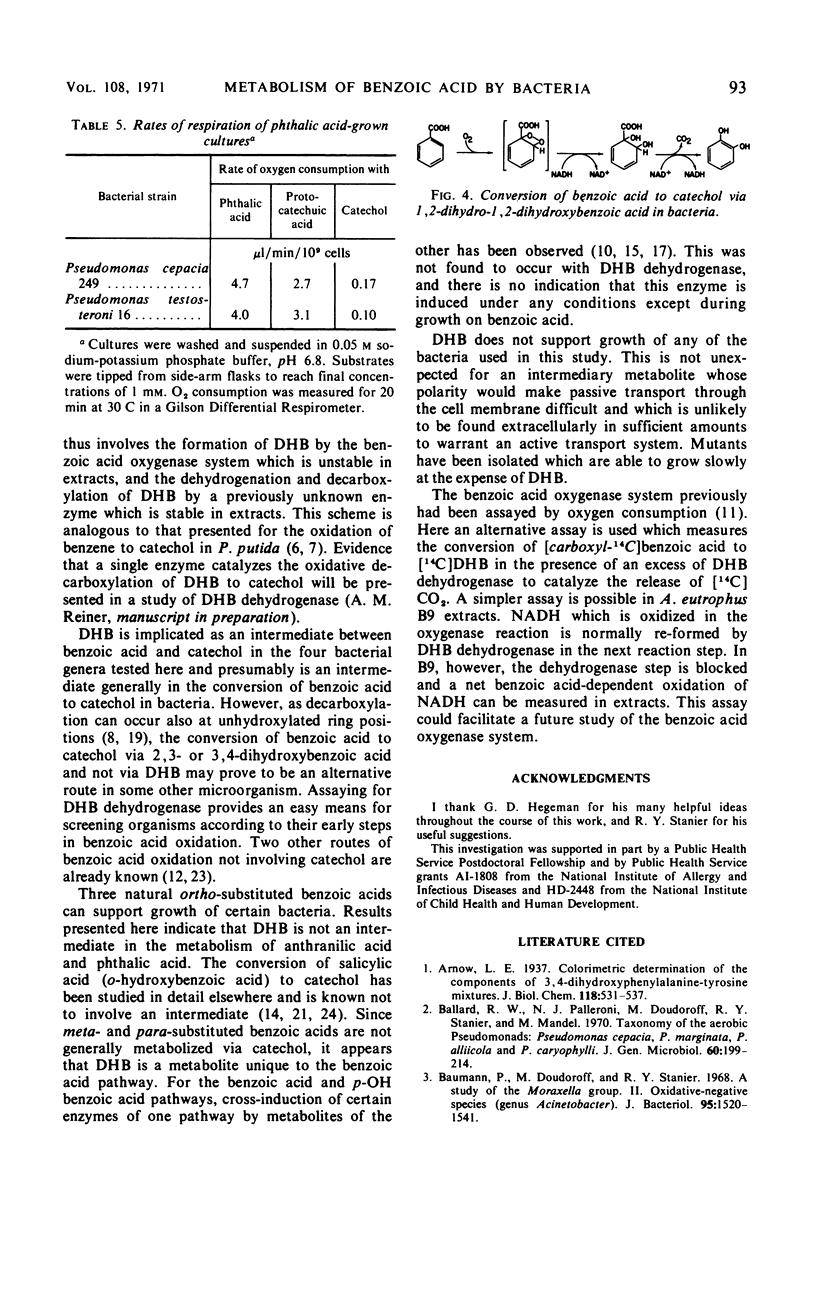Abstract
3,5-Cyclohexadiene-1,2-diol-1-carboxylic acid (1,2-dihydro-1,2-dihydroxy-benzoic acid) is converted enzymatically to catechol in cell extracts from Acinetobacter, Alcaligenes, Azotobacter, and three Pseudomonas species. This enzymatic activity is present only in cultures which have been grown in the presence of benzoic acid, and which convert benzoic acid to catechol rather than to protocatechuic acid. The reaction is assayed by the concomitant formation of reduced nicotinamide adenine dinucleotide from nicotinamide adenine dinucleotide. The conversion of [14C]benzoic acid to [14C]dihydrodihydroxybenzoic acid is demonstrated in cell extracts. A scheme for the conversion of benzoic acid to catechol in bacteria is presented, involving the formation of dihydrodihydroxybenzoic acid from benzoic acid by a dioxygenase which is unstable in cell extracts, followed by the dehydrogenation and decarboxylation of dihydrodihydroxybenzoic acid to catechol by a previously undescribed enzyme. Experiments with anthranilic acid and phthalic acid suggest that dihydrodihydroxybenzoic acid is a metabolite unique to benzoic acid metabolism. Two new methods for assaying benzoic acid dioxygenase are suggested.
Full text
PDF





Selected References
These references are in PubMed. This may not be the complete list of references from this article.
- Ballard R. W., Palleroni N. J., Doudoroff M., Stanier R. Y., Mandel M. Taxonomy of the aerobic pseudomonads: Pseudomonas cepacia, P. marginata, P. alliicola and P. caryophylli. J Gen Microbiol. 1970 Feb;60(2):199–214. doi: 10.1099/00221287-60-2-199. [DOI] [PubMed] [Google Scholar]
- Baumann P., Doudoroff M., Stanier R. Y. A study of the Moraxella group. II. Oxidative-negative species (genus Acinetobacter). J Bacteriol. 1968 May;95(5):1520–1541. doi: 10.1128/jb.95.5.1520-1541.1968. [DOI] [PMC free article] [PubMed] [Google Scholar]
- Gibson D. T., Cardini G. E., Maseles F. C., Kallio R. E. Incorporation of oxygen-18 into benzene by Pseudomonas putida. Biochemistry. 1970 Mar 31;9(7):1631–1635. doi: 10.1021/bi00809a024. [DOI] [PubMed] [Google Scholar]
- Gibson D. T., Koch J. R., Kallio R. E. Oxidative degradation of aromatic hydrocarbons by microorganisms. I. Enzymatic formation of catechol from benzene. Biochemistry. 1968 Jul;7(7):2653–2662. doi: 10.1021/bi00847a031. [DOI] [PubMed] [Google Scholar]
- Gibson D. T. Microbial degradation of aromatic compounds. Science. 1967 Sep 13;161(3846):1093–1097. [PubMed] [Google Scholar]
- Grant D. J., Patel J. C. The non-oxidative decarboxylation of p-hydroxybenzoic acid, gentisic acid, protocatechuic acid and gallic acid by Klebsiella aerogenes (Aerobacter aerogenes). Antonie Van Leeuwenhoek. 1969;35(3):325–343. doi: 10.1007/BF02219153. [DOI] [PubMed] [Google Scholar]
- HAYAISHI O., STANIER R. Y. The bacterial oxidation of tryptophan. III. Enzymatic activities of cell-free extracts from bacteria employing the aromatic pathway. J Bacteriol. 1951 Dec;62(6):691–709. doi: 10.1128/jb.62.6.691-709.1951. [DOI] [PMC free article] [PubMed] [Google Scholar]
- Hosokawa K. Regulation of synthesis of early enzymes of p-hydroxybenzoate pathway in Pseudomonas putida. J Biol Chem. 1970 Oct 25;245(20):5304–5308. [PubMed] [Google Scholar]
- ICHIHARA A., ADACHI K., HOSOKAWA K., TAKEDA Y. The enzymatic hydroxylation of aromatic carboxylic acids; substrate specificities of anthranilate and benzoate oxidases. J Biol Chem. 1962 Jul;237:2296–2302. [PubMed] [Google Scholar]
- Jamaluddin M., Rao P. V., Vaidyanathan C. S. Involvement of the protocatechuate pathway in the metabolism of mandelic acid by Aspergillus niger. J Bacteriol. 1970 Mar;101(3):786–793. doi: 10.1128/jb.101.3.786-793.1970. [DOI] [PMC free article] [PubMed] [Google Scholar]
- Johnson B. F., Stanier R. Y. Regulation of the -ketoadipate pathway in Alcaligenes eutrophus. J Bacteriol. 1971 Aug;107(2):476–485. doi: 10.1128/jb.107.2.476-485.1971. [DOI] [PMC free article] [PubMed] [Google Scholar]
- Kemp M. B., Hegeman G. D. Genetic control of the beta-ketoadipate pathway in Pseudomonas aeruginosa. J Bacteriol. 1968 Nov;96(5):1488–1499. doi: 10.1128/jb.96.5.1488-1499.1968. [DOI] [PMC free article] [PubMed] [Google Scholar]
- LOWRY O. H., ROSEBROUGH N. J., FARR A. L., RANDALL R. J. Protein measurement with the Folin phenol reagent. J Biol Chem. 1951 Nov;193(1):265–275. [PubMed] [Google Scholar]
- Reiner A. M., Hegeman G. D. Metabolism of benzoic acid by bacteria. Accumulation of (-)-3,5-cyclohexadiene-1,2-diol-1-carboxylic acid by mutant strain of Alcaligenes eutrophus. Biochemistry. 1971 Jun 22;10(13):2530–2536. doi: 10.1021/bi00789a017. [DOI] [PubMed] [Google Scholar]
- Ribbons D. W., Evans W. C. Oxidative metabolism of phthalic acid by soil pseudomonads. Biochem J. 1960 Aug;76(2):310–318. doi: 10.1042/bj0760310. [DOI] [PMC free article] [PubMed] [Google Scholar]
- Stanier R. Y., Palleroni N. J., Doudoroff M. The aerobic pseudomonads: a taxonomic study. J Gen Microbiol. 1966 May;43(2):159–271. doi: 10.1099/00221287-43-2-159. [DOI] [PubMed] [Google Scholar]
- TANIUCHI H., HATANAKA M., KUNO S., HAYAISHI O., NAKAJIMA M., KURIHARA N. ENZYMATIC FORMATION OF CATECHOL FROM ANTHRANILIC ACID. J Biol Chem. 1964 Jul;239:2204–2211. [PubMed] [Google Scholar]
- Takemori S., Yasuda H., Mihara K., Suzuki K., Katagiri M. Mechanism of the salicylate hydroxylase reaction. II. The enzyme-substrate complex. Biochim Biophys Acta. 1969 Sep 30;191(1):58–68. doi: 10.1016/0005-2744(69)90314-3. [DOI] [PubMed] [Google Scholar]
- Wheelis M. L., Palleroni N. J., Stanier R. Y. The metabolism of aromatic acids by Pseudomonas testosteroni and P. acidovorans. Arch Mikrobiol. 1967;59(1):302–314. doi: 10.1007/BF00406344. [DOI] [PubMed] [Google Scholar]
- White-Stevens R. H., Kamin H. Uncoupling of oxygen activation from hydroxylation in a bacterial salicylate hydroxylase. Biochem Biophys Res Commun. 1970 Mar 12;38(5):882–889. doi: 10.1016/0006-291x(70)90803-x. [DOI] [PubMed] [Google Scholar]


